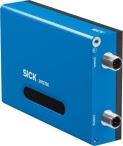
With the SPEETEC®, SICK is expanding its product range for speed and length measurement of objects moving in a linear path to include technology that measures directly on the material surface. The non-contact sensor is able to measure a wide range of web and continuous materials, as well as blanks with an accuracy of just 4 μm.
From a market perspective, the speed sensor closes the gap between tactile, indirect- measuring encoder solutions and laser velocimeters, which are often expensive to purchase and require considerable effort to integrate and operate.
Slip-resistant, without measuring elements, without damaging sensitive surfaces and without wear and tear on tactile sensor elements – the SPEETEC® from SICK is an innovative, non-contact sensor for speed and length measurement of objects moving in a linear path.
Look, but don’t touch: The sensor for special materials
For sensitive, soft, or smooth surfaces, customers from factory or logistics automation require non-contact measurement options for the length, speed, and position of continuous webs and blanks. Optical scanning prevents damage or contamination, thereby increasing product quality.
The SPEETEC® offers a new way to measure without slip, measuring elements or marking, and wear and tear on tactile sensor elements. Materials that cause wear, adhesion, or abrasion damage to measurement solutions such as measuring wheel encoders, impairing their function, can be measured by the SPEETEC® with a high degree of process reliability and availability.
Safe and highly accurate measurement principle
Since the SPEETEC® is equipped with class 1 lasers, it offers an alternative to expensive laser velocimeters and the associated costly protective measures. The return on investment (ROI) is particularly attractive. For the SPEETEC®, this is less than a year.
The non-contact measurement is performed with a laser Doppler process at speeds of up to 10 m/s. Two transmitters emit laser light – one in the direction of movement of the material, the other in the opposite direction. Since the transmitters work independently, possible mounting tolerances and surface fluctuations (i.e., with wavy surfaces) can be balanced out.
All measurements are done with high precision. At a resolution of four micrometers, the accuracy relating to the object length of a meter is one millimeter. The repeatability in this case is specified with a half a millimeter. Measured values are output via the TTL or HTL interfaces common in the encoder world, making integration easy.
Better productivity while saving resources
With the SPEETEC®, length, speed and position can also be detected in linear movements when switching between forward and backward motions. In addition, acceleration measurement in applications with high motion dynamics is possible since, with the SPEETEC®, only three milliseconds pass between the start of the movement and the output of measured values.
Contact Details
Related Glossary Terms
- web
web
On a rotating tool, the portion of the tool body that joins the lands. Web is thicker at the shank end, relative to the point end, providing maximum torsional strength.
